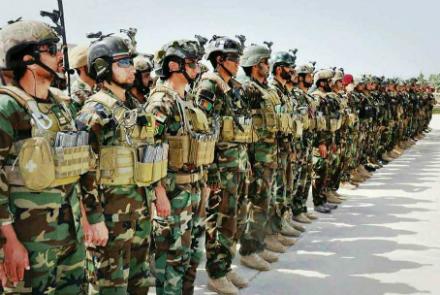The Ministry of Defense on Friday said that the number of soldiers in the ranks of the Afghan National Army (ANA) is supposed to be around 234,000 officers, however, currently there are about 200,000 soldiers serving in the force.
Afghanistan started reshaping its security institutions after the fall of the Taliban regime in 2001, a move that is considered one of the major achievements of state-building programs in the country in the post-Taliban democracy.
“The size of the army should be about 234,000, but currently there are around 200,000 soldiers serving,” confirmed Rohullah Ahmadzai, spokesman for the Afghan Ministry of Defense, but he downplayed the significance of the difference: “But the recruitment process is normal for a national army.”
Toofan Mahdavi, a former officer of the Afghan National Army who served in the force for three years and was wounded during one of the battles, said that a lack of troops has serious consequences. He left the military because he was personally threatened by armed groups because he served in the ANDSF, but another reason he gave for leaving was “challenges on the battlefield.” Mahdavi cites a lack of troops as one of the challenges:
“When we asked ‘why didn’t you send us reinforcements?’ they said that they didn’t hear our voice on the line. We did not have sufficient personnel. When the checkpoints are taken by the Taliban and you come tomorrow, what is the benefit of that?” said Mahdavi.
The high number of casualties among Afghan forces is also one of the factors that has been hindering the ability to meet target numbers of enlistment.
“When there is money, but there is no feeling for the country—and weak leadership—it’s natural, it will never be complete,” said military expert Atiqullah Amarkhel.
Meanwhile, the Ministry of Interior has said they are trying to build up the force to its target numbers.
“We have a two percent shortage. But the recruitment process is underway in the center and in the provinces,” said Nusrat Rahimi, a spokesman for the Ministry of Interior.
In July 2019, John Sopko, the US Special Inspector General for Afghanistan Reconstruction (SIGAR), in a report said that the size of Afghanistan’s National Defense and Security Forces reported the lowest numbers since the Resolute Support mission began in January 2015.
According to the report, there were 180,869 Afghan National Army (ANA) and 91,596 Afghan National Police (ANP) personnel enrolled and accounted for as of May 25, 2019, which is roughly 10,000 ANA fewer and 25,000 ANP fewer than the numbers reported to SIGAR in the previous quarter.
Part of the drop was attributed to different standards of counting, in this case counting only biometrically-validated soldiers.


